Propulsion: Two Babcock and Wilcox boilers, one triple expansion reciprocating steam engine, one shaft1944 - Two 200psi saturated steam Babcock and Wilcox header boilers, one 1,400shp Baltimore Shipbuilding and Dry Dock Co. vertical triple expansion reciprocating steam engine.
Click on thumbnail
for full size image |
Size |
Image Description |
Source |
USS Lark (Minesweeper No. 21)
|
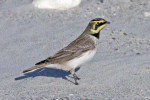 |
37k |
Namesake: Lark - Any of a large group of songbirds found throughout the world |
Tommy Trampp |
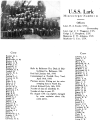 |
249k |
Photo from "Sweeping the North Sea Mine Barrage" by the U.S. Navy North Sea Minesweeping Detachment |
Joe Radigan |
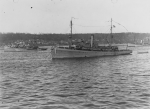 |
143k |
Review of the Atlantic Fleet Minesweeping Squadron, November 1919. Lapwing (Minesweeper No. 1) and other ships of the squadron anchored in the Hudson River, off New York City, while being reviewed by Secretary of the Navy Josephus Daniels on 24 November 1919, following their return to the United States after taking part in clearing the North Sea mine barrage. The other ships visible are: Lark, with USS SC-208 alongside (at left); and USS Swan (Minesweeper No. 34) with USS SC-356 alongside (at right)
U.S. Navy photo NH 44903 |
Naval Historical Center |
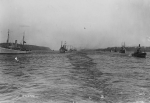 |
118k |
Review of the Atlantic Fleet Minesweeping Squadron, November 1919. Ships of the squadron anchored in the Hudson River, off New York City, while being reviewed by Secretary of the Navy Josephus Daniels on 24 November 1919, following their return to the United States after taking part in clearing the North Sea mine barrage. Identifiable ships present include (left column, from front to rear): USS Turkey (Minesweeper No. 13); USS Quail (Minesweeper No. 15) with SC-354 alongside; Lark with SC-208 alongside; USS Swan (Minesweeper No. 34) with SC-356 alongside; and USS Flamingo (Minesweeper No. 32) with an unidentified submarine chaser alongside. (right column, from front to rear): USS Thrush (Minesweeper No. 18); Two unidentified minesweepers, one of which is probably Lapwing; USS Kingfisher (Minesweeper No. 25); and, in no particular order, tugs Patapsco and Patuxent. USS
SC-245 is at the far right, passing between the two anchored columns
U.S. Navy photo NH 44904 |
USS Lark (AM 21)
|

110202111 |
249k |
Panoramic crew photo, circa 1930s. The officer to the right of the lifering appears to be LT Hugh D. Black, Lark's commanding officer from 1935 to 1938. |
Dave Wright |
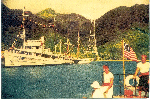 |
209k |
c. 1939
HUSKY SAMOAN NATIVES, ENLISTED IN THE U.S. NAVY MAINLY FOR LOCAL DUTY, MAN A BOAT IN PAGO PAGO HARBOR. - Known as the Fita-Fita Guard, their uniform includes regulation Navy undershirt, native loincloth and red cap. The Yankee is anchored astern of the USS Lark, a minesweeper, in the mountain-girt port of this United States outpost in the South Pacific.
National Geographic Society photo by Malcolm Evans |
Royce W. Grimes |
 |
155k |
c. 1943
Australia |
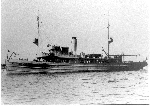 |
175k |
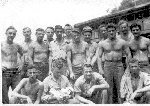 |
164k |
c. 1943
The Black Gang (Engineers) |
USS Lark (AT 168)
|
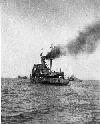 |
45k |
c. 1944 |
Royce W. Grimes |
USS Lark (AT[O] 168)
|
 |
110k |
c. 1944
Hollandia, New Guinea |
Royce W. Grimes |
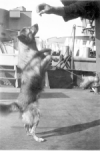 |
45k |
Ships mascot "Digger" |
 |
172k |
c. 1946
Lark's last get together. Put the ship out of commission in February 1946 and all went home
Richard Meek's Mother and Father are in the picture (rear middle against the wall and to the right of the door). They were married in 1946, just before the picture was taken and the Lark
was decommissioned.
Photo by Plymouth Pictures of San Francisco, CA |
Original photo: Royce W. Grimes
Replacement photo: Richard Meeks |
Commanding Officers
|
| 01 | LT Henry Aloysius Stanley, USN - Awarded the Navy Cross (1919) | 12 April 1919 |
| 02 | LTJG Svend Julius Skou, USN | 10 December 1920 |
| 03 | LTJG Clarence Vernon Waggoner, USN - Awarded the Navy Cross (1919) | 7 January 1921 |
| 04 | LT Robert Rohange, USN - Awarded the Navy Cross (1919)
Retired as Lieutenant | 26 December 1921 |
| 05 | LT Niels Drunstrup, USN - Awarded the Medal of Honor (1914) and the Navy Cross (1919)
Retired as Lieutenant Commander | 28 October 1923 - 27 November 1923 |
| 06 | LT John McCloy, USN - Awarded two Medals of Honor (1910/1914) and the Navy Cross (1919) | 27 November 1923 |
| 07 | LT Rony Snyder, USN - Awarded the Legion of Merit (1943) | 14 October 1927 - 1930 |
| 08 | LT John Wendell Jamison, USN - Awarded the Legion of Merit (1945) | 2 October 1930 |
| 09 | LT Nealy Adolphus Chapin, USN - Awarded the Legion of Merit (1945) | 27 May 1933 - January 1935 |
| 10 | LT Hugh David Black, Jr., USN | 2 January 1935 - January 1938 |
| 11 | LT John Orla Jenkins, USN | 15 January 1938 - 30 November 1939 |
| 12 | Chief Boatswain Howard William Mabus, USN | 30 November 1939 - 25 January 1940 (Acting) |
| 13 | LT John Orla Jenkins, USN | 25 January 1940 - March 1941 |
| 14 | LCDR Hugh Pollard Thompson, USN | 31 March 1941 - 1942 |
| 15 | LCDR Eugene Carter Rider, USN - USNA Class of 1934
Awarded the Silver Star (1942) - Retired as Captain | 23 March 1942 |
| 16 | LCDR Rowe, USN | 30 April 1943 - June 1944 |
| 17 | LCDR Paul C. Lindlay, Jr., USNR - Retired as Captain | 6 June 1944 - 18 June 1945 |
| 18 | LT Herbert Fendle Hugo, USN | 18 June 1945 - 7 February 1946 |
|
Courtesy Wolfgang Hechler, Ron Reeves and Joe Radigan
|
View the Lark (AM 21)
DANFS history entry located on the Haze Gray & Underway website
"THE MIGHTY LARK RETURNS"
1944The U.S.S. Lark is a Seagoing Tug to be exact, but to her crew is more than this; she is the "Mighty Lark."Our ship is not an inanimate object, but rather a living, pulsating being to all of us who have come to depend upon her for our very life; each one of us has a definite job to do, as members of her crew, and it is the aggregate of these duties that is the life's blood of our "Good Ship."
The Mighty Lark is no softie, nor is she an infant, but a mature lady that can (when the occasion arises) perform most any task that her "Uncle" calls upon her to do; for over a quarter of a century, she has not failed him, but has served him faithfully and when the going got the toughest, she did not flinch, but turned to, with a will that left no doubt, as to her being a true American.
To serve one's country in peace and war for so long a time, in such an admirable manner as the Lark has is one thing; to do this with no world acclaim is another; it is easy to keep on when the world's applause rings in one's ear, but to steadily plod along, doing the more difficult tasks (such as a seagoing tug is forever doing) requires courage beyond the average conception of the word.
When the time came for "Uncle Sam's" ships to leave the Philippines Islands, temporarily, then the "Mighty Lark" was the last to do so; reluctantly, she sailed away with the admonition, she would return.
Now, after two years; hard years, weary hours, silent service, the "Mighty Lark" returns to the Philippines bringing with her, many of her "Sisters" and the much needed materials of war; she is a bit older, but stronger than ever and "Armed to the Teeth;" she looks stately in her battle dress of blue-gray and proud as she leads her little fleet of tugs into San Pedro Bay, and will give a good account for herself to anyone who might attempt to stop her.
Our lady remembers the time when she was dressed in white and when her spotless decks echoed a bit more laughter; because of this, she is happy to be coming home; this is her home, for it has been many years since she has been to the United States; no stateside leave for her, she was always too busy.
We of the crew, also, are proud and happy to share the "Mighty Lark" homecoming, for we are a part of her; we recall the many tasks that we have accomplished together. We think of all the former members of the crew, many of whom are in far distant places, on other ships, or at other bases, who will rejoice with us when the news of the Lark's return reaches them, for we know that they too have a tender spot in their hearts for the "Good Ship" on which they once served.
There are larger ships in the fleet, but none can boast of being independent of the "Seagoing Tugs" who are always in there "Pitching" to lend a helping hand to another ship in distress, or towing barges and supplies to where ever they may be needed, in fair weather or foul and to fight if needed, to accomplish the appointed task.
The "Mighty Lark" and her sister tugs are always ready to go any place and to pull anything afloat; other ships depend upon them and are secure in the knowledge that the tug will not fail them; this is the "Lark's" compensation for her efforts; she expects no medals or commendation, other than the honor her "Uncle" pays her when he says "Well Done."
(Author unknown) - Courtesy of Royce W. Grimes
LETTER FROM PAUL LINDLEY, FORMER COMMANDING OFFICER OF LARK, TO THE 1984 CREW MEMBERS REUNION1 June 1984
DEAR SHIPMATES, USS LARK,Forty years ago this month, the LARK was in BRISBANE being converted from an AM to an ATO. Toward the end of June I relieved LCDR Rowe as Commanding Officer. We were along side a pier in the Brisbane River.We sailed from Brisbane towing a large Australian FERRY BOAT (circa 1850) that was to be used as a floating machine shop in the forward area. We went up the coast to Cairns, across the CORAL SEA to Milne Bay, NEW GUINEA. Shortly after arrival we were sent out to salvage a U.S. LCI that was aground on a coral reef.We operated out of Milne Bay, up the coast of NEW GUINEA to such places as FINSCHHAFEN, HOLLANDIA, ADMIRALITY ISLAND, MIOS WOENDI, and other ports I do not remember. The LARK was part of the invasion force at the island of MOROTAI. We towed an LST back to Manus.On one of our trips to the Admiralties one of our crew had an appendix [attack]. OL' DOC (CPHM LOVELACE ??) packed him ice for two days and he made it into MANUS for a successful operation. Do you all remember the big fleet concentration in Manus Harbor?? Battle Ships, Cruisers, Flat Tops, Destroyers, and every type of Auxiliary and Amphib. We did not know it at the time, but Manus was one of the staging areas for the invasion of the Philippines.We were ordered back to MIOS WOENDI, and told to prepare to tow (long distance) a gasoline barge (Very Large) ,a PT drydock, and a Quonset Hut mounted on steel pontoons.In early October we sailed north from Mios Woendi, under sealed orders. Several days later we rendezvoused with a large convoy of other tugs towing assorted barges, cranes, etc's. We were escorted by two USN PC's. We opened our orders and found we were en route to LEYTE GULF PI with the invasion due 20 October 1944.We entered Leyte Gulf early morning 25 October. The battle for SURIAGO STS. was in progress, as the Jap BB's tried to enter the gulf. Our Battle Ships "crossed the T" and prevented the entrance. That saved Leyte. Those on the bridge of the LARK saw the illumination of the shelling and did not realize they were watching history being made. We did not find out about it till later in the day. We sure were glad to get rid of that barge load of high octane gas, and the PT boats were glad to get it.At Leyte I feel sure we shot down two jap planes. We were called on for many duties in the gulf. We went through a typhoon, lost an anchor and messed up a screw (my responsibility) made smoke, stayed at GQ, helped put out a gasoline fire on a U.S. merchant ship that was hit by a Jap Kamikaze, and went through numerous air raids.To my knowledge the LARK was the only ship that was in Manila P.I. in Dec. 1941 that also RETURNED to the Philippines on the first invasion at Leyte Oct. 1944.After Leyte we returned to Hollandia for a new screw and tender availability along side USS DOBBIN [AD 3].We were ordered back to the Philippines, but only made about a hundred miles when one of the boilers caved in. So we returned to Hollandia: to wait for new tubes.I was relieved by Lt. Hugo in June 1945. After Korea I became very active in the organized Naval Reserve and retired after 31 years as a four striper. I now live in BEAUFORT S.C. home of the Paris Island Marines. Lots of retired military here, so you hear plenty of sea stories.I believe that Mr Parks (Engineering off) is deceased. I saw CCS Dan Smith shortly after the end of WW II.There was one incident I will never forget: In Dec. 1944 we were able to draw a full Xmas meal (fresh & frozen) from a Reefer Ship in Hollandia.On Xmas day we were underway off the coast of New Guinea, temperature 110°. The CPHM advised me that our outside reefer had been out for several days and that everything was spoiled. ALL the meat, turkey, and trimmings had to go over the side. So we ended up with canned spam, canned vegetables,and a few nuts that had to be cracked.Don't know of any ship I've served aboard that I felt closer to, or had so much history to tell in her life time:
Swept mines off the coast of Europe at the end of WW I.
Was station ship in American Samoa.
Outwitted the Japs at Manila.
Fought with the Dutch Navy in Java.
Made it safely to Australia. Worked with American Subs out of Perth.
Was only U.S. ship to return to Philippines at first invasion.
And was maintained, held together, and sailed by a hard working, dedicated, bunch of great American Sailors.I salute you and only wish I could be on board with you for the reunion.Respectfully
s/ Paul
Paul LindleyP.S.
Didn't we have a dog named Digger?
Additional Resources and Websites of Interest
|
Problems and site related matters, E-mail Webmaster
|
This page was created and maintained by Joseph M. Radigan (of blessed memory) & David L. Wright
All Pages © 1996 - 2024, NavSource History, All rights reserved. |
Last Updated 06 May 2024